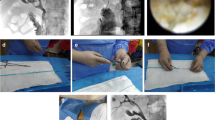Abstract
Purpose
To present our experience in biliary stone removal (BSR) through the percutaneous transhepatic biliary drainage (PTBD) route in 916 patients, and discuss its clinical usefulness.
Materials and methods
From 2001 to 2015, 916 patients (479 male patients and 437 female patients; age range, 22–92 years; mean age, 67 years) with 52 recurring cases, so a total of 968 cases, were enrolled in this study and retrospectively reviewed. PTBD was performed in all patients. BSR was performed using a combination of a balloon sphincteroplasty flushing technique, a pushing technique after sphincteroplasty, and classical extraction technique, decided case by case.
Results
A complete removal was achieved in 893 cases (92.3%) and the overall clinical success rate was 99.3%. Failure occurred in 7 cases (0.7%), and the causes of failure were stone impaction (n = 5) and intrahepatic bile duct stricture (n = 2). Sphincteroplasty was performed in 902 cases (93.2%). Balloon sphincteroplasty flushing technique was used in 829 (85.6%) cases. There was no major complication. Transient minor complications were seen in 86 cases (8.9%).
Conclusions
BSR through the PTBD route using a combination of techniques, including balloon sphincteroplasty flushing, is a safe and effective treatment modality to remove biliary stones.



Similar content being viewed by others
References
Riciardi R, Islam S, Canete JJ, Arcand PL, Stoker ME. Effectiveness and long-term results of laparoscopic common bile duct exploration. Surg Endosc. 2003;17:19–22.
Freeman ML. Complications of endoscopic sphincterotomy: a review. Endoscopy. 1997;29:288–97.
Bergman JJ, van Berkel AM, Groen AK, Schoeman MN, Offerhaus J, Tytgat GN, et al. Biliary manometry, bacterial characteristics, bile composition, and histologic changes fifteen to seventeen years after endoscopic sphincterotomy. Gastrointest Endosc. 1997;45:400–5.
Freeman ML, Nelson DB, Sherman S, Haber GB, Herman ME, Dorsher PJ, et al. Complications of endoscopic biliary sphincterotomy. N Engl J Med. 1996;335:909–18.
Miller BM, Kozarek RA, Ryan JA Jr, Ball TJ, Traverso LW. Surgical versus endoscopic management of common bile duct stones. Ann Surg. 1988;207:135–41.
Neoptolemos JP, Carr-Locke DL, Fraser I, Fossard DP. The management of common bile duct calculi by endoscopic sphincterotomy in patients with gallbladders in situ. Br J Surg. 1984;71:69–71.
Ilgit ET, Gurel K, Onal B. Percutaneous management of bile duct stones. Eur J Radiol. 2002;43:237–45.
Ozcan N, Erdogan N, Baskol M. Common bile duct stones detected after cholecystectomy: advancement into the duodenum via the percutaneous route. Cardiovasc Intervent Radiol. 2003;26:150–3.
Park YS, Kim JH, Choi YW, Lee TH, Hwang CM, Cho YJ, et al. Percutaneous treatment of extrahepatic bile duct stones assisted by balloon sphincteroplasty and occlusion balloon. Korean J Radiol. 2005;6:235–40.
Gil S, de la Iglesia P, Verdu´ JF, de España F, Arenas J, Irurzun J. Effectiveness and safety of balloon dilation of the papilla and the use of an occlusion balloon for clearance of bile duct calculi. Am J Roentgenol. 2000;174:1455–60.
Sacks D, McClenny TE, Cardella JF, Lewis CA. Society of interventional radiology clinical practice guidelines. J Vasc Interv Radiol. 2003;14:S199–202.
Cheon YK, Cho YD, Moon JH, Lee JS, Shim CS. Evaluation of longterm results and recurrent factors after operative and nonoperative treatment for hepatolithiasis. Surgery. 2009;146:843–53.
Lee SK, Kim MH. Updates in the treatment of gallstones. Expert Rev Gastroenterol Hepatol. 2009;3:649–60.
Kawai K, Akasaka Y, Murakami K, Tada M, Koli Y. Endoscopic sphincterotomy of the ampulla of Vater. Gastrointest Endosc. 1974;20:148–51.
Ersoz G, Tekesin O, Ozutemiz AO, Gunsar F. Biliary sphincterotomy plus dilation with a large balloon for bile duct stones that are difficult to extract. Gastrointest Endosc. 2003;57:156–9.
Park SJ, Kim JH, Hwang JC, Kim HG, Lee DH, Jeong S, et al. Factors predictive of adverse events following endoscopic papillary large balloon dilation: results from a multicenter series. Dig Dis Sci. 2013;58:1100–9.
Yasuda I, Itoi T. Recent advances in endoscopic management of difficult bile duct stones. Dig Endosc. 2013;25:376–85.
Mueller PR. Biliary interventions: a historical perspective. Semin Intervent Radiol. 1996;13:197–200.
Fennessy JJ, You KD. A method for the expulsion of stones retained in the common bile duct. Am J Roentgenol. 1970;110:256–9.
Perez MR, Oleaga JA, Freiman DB, McLean GL, Ring EJ. Removal of a distal common bile duct stone through percutaneous transhepatic catheterization. Arch Surg. 1979;114:107–9.
Dotter CT, Bilbao MK, Katon RM. Percutaneous transhepatic gallstone removal by needle tract. Radiology. 1979;133:242–3.
Centola CA, Jander HP, Stauffer A, Russinovich NA. Balloon dilatation of the papilla of Vater to allow biliary stone passage. Am J Roentgenol. 1981;136:613–4.
Meranze SG, Stein EJ, Burke DR, Hartz WH, McLean GK. Removal of retained common bile duct stones with angiographic occlusion balloons. Am J Roentgenol. 1986;146:383–5.
Mac Mathuna P, Siegenberg D, Gibbons D, Gorin D, O’Brien M, Afdhal NA, et al. The acute and long-term effect of balloon sphincteroplasty on papillary structure in pigs. Gastrointest Endosc. 1996;44:650–5.
Minami A, Nakatsu T, Uchida N, Hirabaytashi S, Fukuma H, Morshed SA, et al. Papillary dilation vs sphincterotomy in endoscopic removal of bile duct stones. A randomized trial with manometric function. Dig Dis Sci. 1995;40:2550–4.
Garcia-Garcia L, Lanciego C. Percutaneous treatment of biliary stones: sphincteroplasty and occlusion balloon for the clearance of bile duct calculi. Am J Roentgenol. 2004;182:663–70.
Garcia-Vila JH, Redondo-Ibanez M, Diaz-Ramon C. Balloon sphincteroplasty and transpapillary elimination of bile duct stones: 10 years’ experience. Am J Roentgenol. 2004;182:1451–8.
Ozcan N, Kahriman G, Mavili E. Percutaneous transhepatic removal of bile duct stones: results of 261 patients. Cardiovasc Intervent Radiol. 2012;35:621–7.
Yoo SM, Shim HJ, Kwak BK, Lee HY, Lim SJ, Park HJ, et al. Residual intrahepatic stones after percutaneous biliary extraction: long-term follow up of complications. J Korean Radiol Soc. 1997;37:285–9.
Author information
Authors and Affiliations
Corresponding author
Ethics declarations
Conflict of interest
The authors declare that they have no conflict of interest.
About this article
Cite this article
Shin, J.S., Shim, H.J., Kwak, B.K. et al. Biliary stone removal through the percutaneous transhepatic biliary drainage route, focusing on the balloon sphincteroplasty flushing technique: a single center study with 916 patients . Jpn J Radiol 35, 440–447 (2017). https://doi.org/10.1007/s11604-017-0651-x
Received:
Accepted:
Published:
Issue Date:
DOI: https://doi.org/10.1007/s11604-017-0651-x




